Looking for an opportunity that can grow from a side hustle to a regular, passive income? You’ll need need two things: a product to sell, and a shortcut to avoid burning out. Enter Private Label Rights, or PLR.
Whether you're a beginner entrepreneur or looking for a new online income stream, PLR offers a solution to sellers that saves both time and effort, allowing you to start making money without any extensive labor.
So let’s get into it. Before we start explaining how you can leverage PLR, it's important to understand exactly what differentiates it from other types of product licenses.
What is PLR?
Private label rights, commonly called PLR, refer to a licensing model allowing you to purchase pre-made digital products, modify them, and resell them again under your brand or business. The point of PLR products is that they can be edited, customized, and branded as if they were your own. Think ebooks, courses, templates–the list goes on.
Why choose a PLR product instead of building your own? Well, one of the most attractive features of PLR is the time and effort it saves you. Rather than starting from scratch, you’re working with an existing product. This allows anyone to become a course-builder or ebook author. Plus, saving time lets you focus on personalizing and marketing the product. Basically, PLR streamlines the whole process of building and scaling a digital business.
What's the Difference Between PLR, Resale Rights, and Master Resale Rights?
To fully understand the benefits of PLR, it helps to compare it to other types of digital product licenses. If you’ve heard of resale rights and master resale rights, you might be scratching your head over the difference between each term. While they all sound similar, each license type offers different levels of customization and potential for profit.
Resale rights
When you purchase a product with resale rights, you’re allowed to sell the product as-is. This means you can offer your customers the product but can’t alter its content or branding. It’s a straightforward method where you act as a middleman, offering the product in its original form. For beginners, resale rights can help you start selling digital products quickly; however, building a brand or sustainable business through this method alone can be hard. Offering the same generic product as many other sellers can make it harder to stand out online.
Master resale rights
Master resale rights allow you to sell a product and simultaneously grant resale rights to your customers. In other words, not only can you sell the product, but you can also let your buyers sell it themselves. This can create an extended network of sellers promoting your product, increasing sales. However, it also takes away from your competitive edge. Plus, master resale rights can be seen as a pyramid scheme of sorts, and so is looked upon unfavorably by certain buyers.
Private label rights (PLR)
This brings us to private label rights (PLR), which provide digital entrepreneurs the most flexibility. As mentioned above, with PLR, you modify the base content, rebrand it, and add or remove material. With this level of customization, you’re more likely to create a product with a USP that resonates with your target audience. PLR means you’re not just reselling an existing product but transforming it into something valuable and leaving your own mark.
5 Examples of PLR Digital Products
Here’s a look at some of the most popular types of PLR digital products and how you can use them to start selling:
1. Ebooks
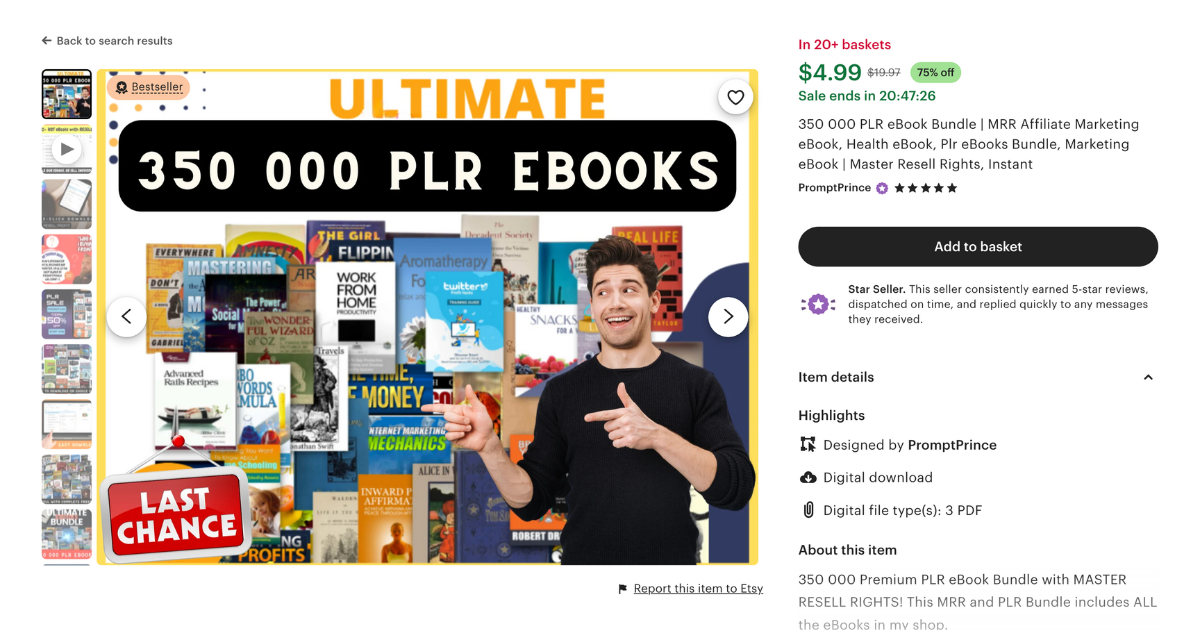
Ebooks are one of the most commonly sold PLR products. A huge benefit of ebooks is that they can cover virtually any topic, from self-help and personal development to niche-specific guides. With PLR ebooks, all you have to do is modify the content to add your own information, insights, and brand. You can make simple, minimal edits or purchase a PLR ebook as an outline to create something entirely new. Personal trainers, for example, could purchase a PLR ebook on nutrition, add their own workout routines, and sell it as a comprehensive health guide.
2. Social media templates
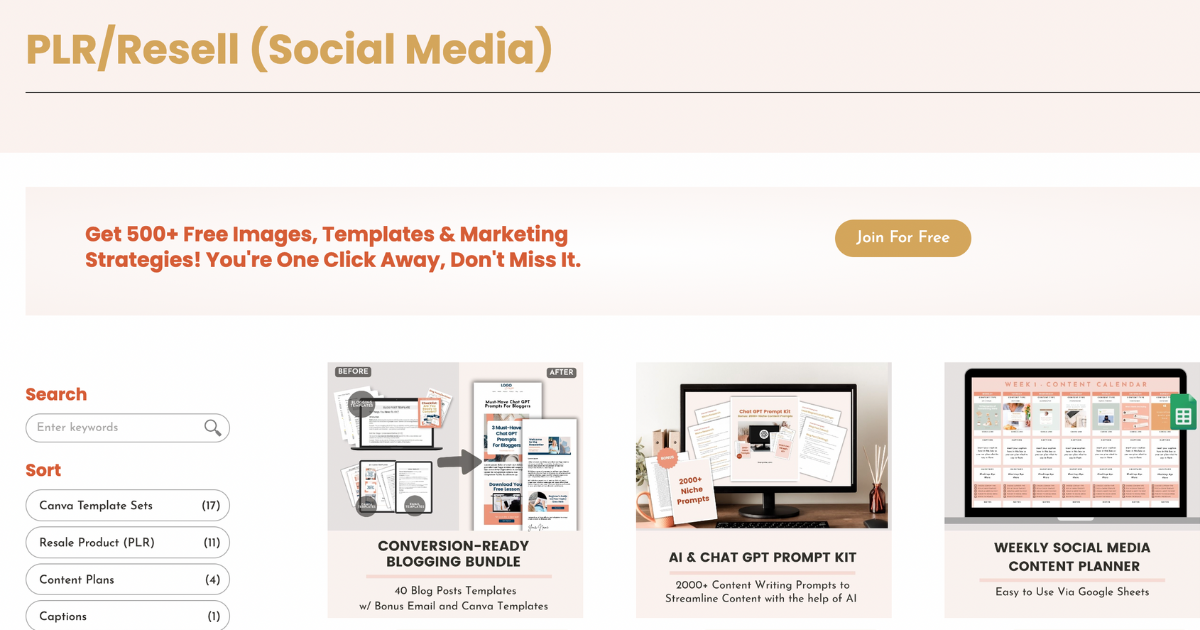
Not everyone is a designer or a social media whizz–but almost every business is on social media.
Social media templates are a popular digital product, as they allow anyone to create consistent and on-brand content for their business–but they can take time and effort to make. By selling PLR templates, you can tap into this market without any extensive experience in design or social media and begin selling templates right away.
3. Online courses
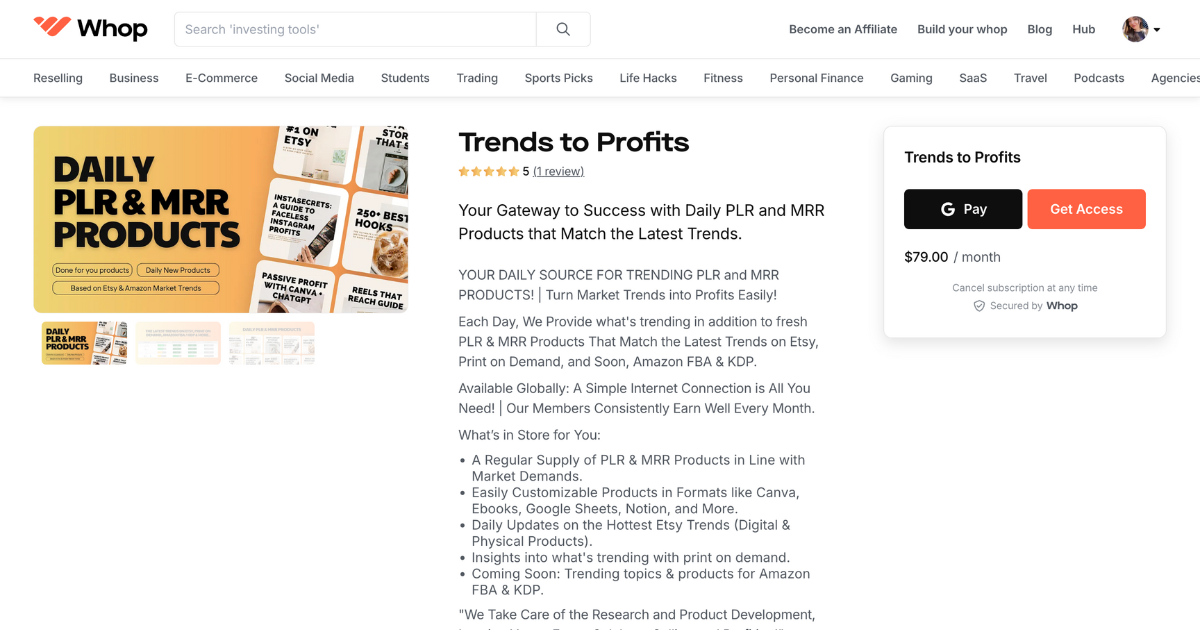
If you’ve dreamed of building an online course, PLR offers a unique opportunity to provide educational content without the need to develop it from scratch.
As with any PLR product, the more value you add, the better. You can (and should) customize the course material, add your own modules, and even create extra, interactive elements like quizzes or assignments. Plus, for beginners, buying a PLR course can give you the framework to understand how course-building works and gain the confidence to build your own from scratch.
4. Planners
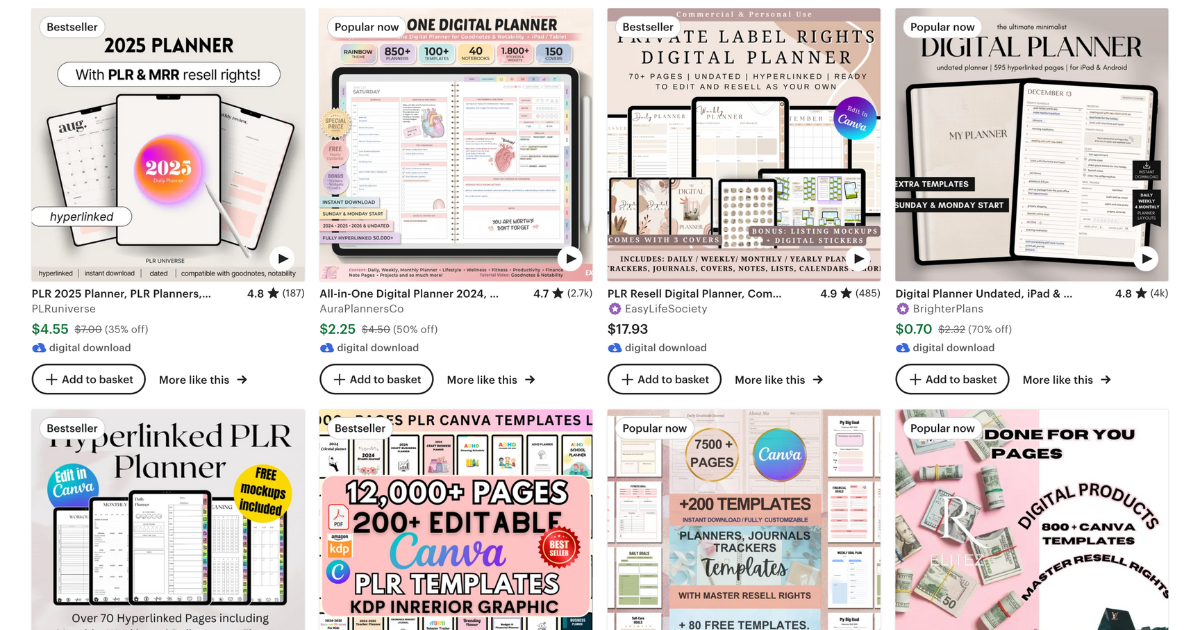
Digital planners are increasingly popular among those who want to stay organized and productive. In fact, a recent ECAL survey found that 70% of adults in the US use some kind of digital calendar or planner.
Buying a PLR journal model allows you to modify and create various products from one, such as daily, weekly, or monthly planners. You can theme them towards certain demographics, such as health and wellness or creative projects. For example, you could create a productivity planner with PLR content and add your own motivational quotes, imagery, and tips to cater to a niche audience.
5. Journals
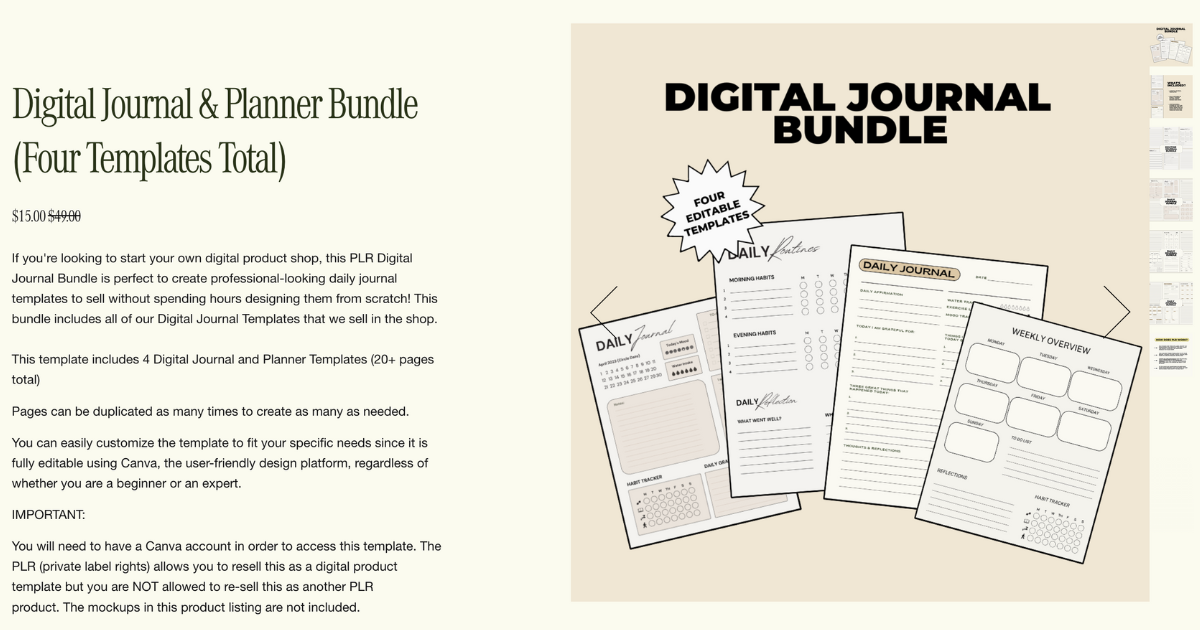
Similarly to planners, PLR journals can be tailored to suit various purposes, from gratitude to goal-setting.
Have you ever wanted to create a journal, but the manual labor of building and formatting put you off? PLR is perfect for you. Purchase the base model, saving you extensive time, and get straight to personalizing with prompts, designs, and branding. If your target audience focuses on personal development, you could use PLR journals to create a self-reflection journal, complete with unique exercises and inspirational content.
Making Money With PLR Products: How Easy is it, and How Much Can You Earn?
Now we get to the main factor: money. With PLR, your earning potential varies greatly depending on the product type, sales cost, and your marketing efforts.
For instance, selling a well-targeted ebook or online course can potentially bring in hundreds to thousands of dollars in revenue, depending on your audience, pricing model, and marketing capability. Social media templates and planners also offer lucrative opportunities, especially if you bundle them or offer seasonal variations. But, any success with PLR requires putting in the work to build a brand and audience.
Beyond earning potential? The true beauty of PLR products is their simplicity. It really is as easy as 1-2-3 to get started:
1. Source your PLR digital product
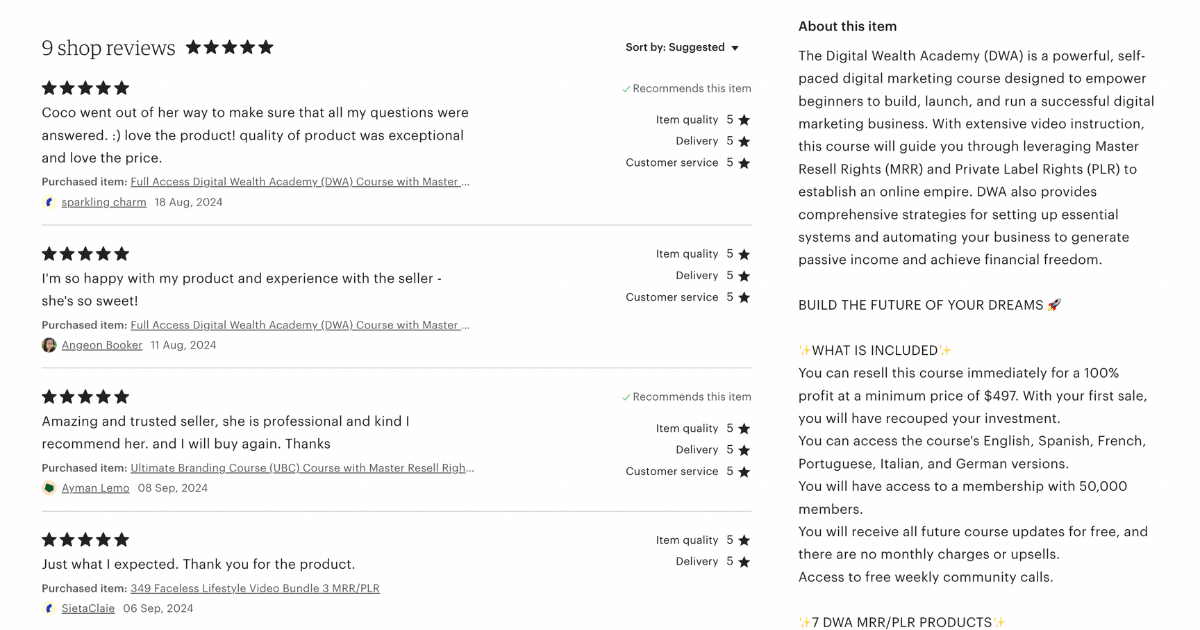
First, you’re going to want to find a reputable provider of PLR products.
With so many options flooding the online space, it’s important to take the time to research and choose a seller that offers high-quality products. Try to look for reviews, sample content, and any guarantees or support options provided. If possible, contact the seller via the marketplace or social media to ask any questions you might have or check their product description for FAQs.
Remember, your choice of PLR product will significantly impact your results. Look for listings that include high-resolution sneak peeks and have a favorable rating.
2. Make your edits
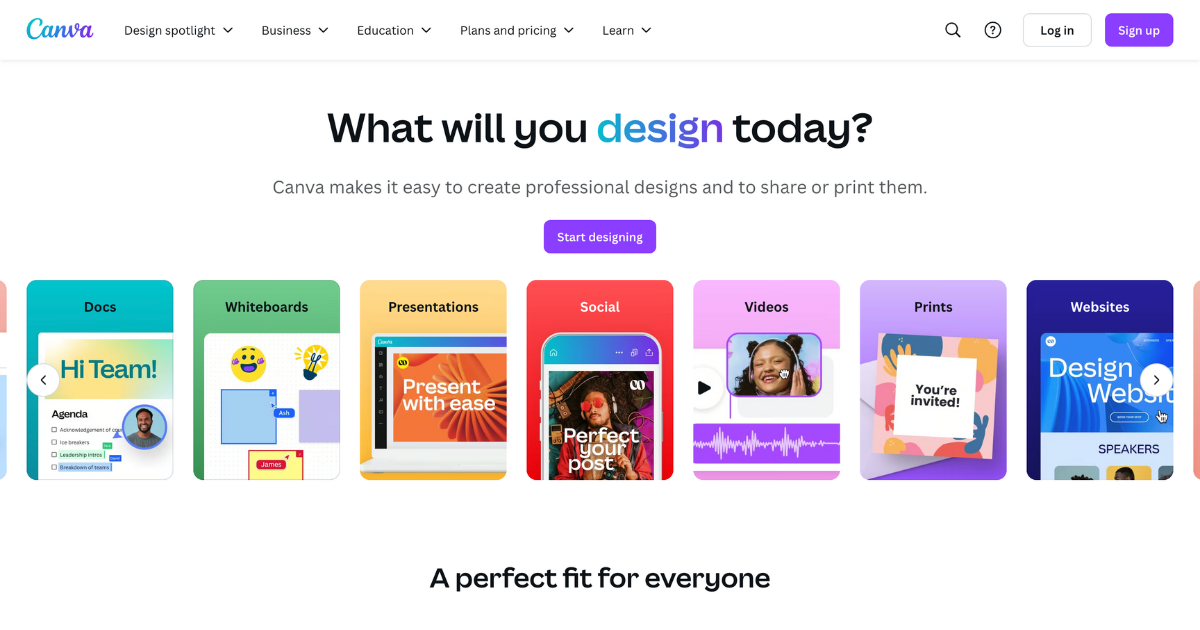
After acquiring your PLR product, the next step is to start personalizing.
For instance, if you’ve purchased a PLR ebook, you might want to update the introduction, add your branding elements, and include additional chapters or sections that reflect your expertise. If you’re working with social media templates, customize the designs to match your brand’s visual identity. The more effort you put into your customization, the more likely your product will appeal to your audience.
Depending on which product you choose, you’ll likely need access to software like Canva or Photoshop to modify and repurpose the content.
3. Upload to your store or marketplace and start selling
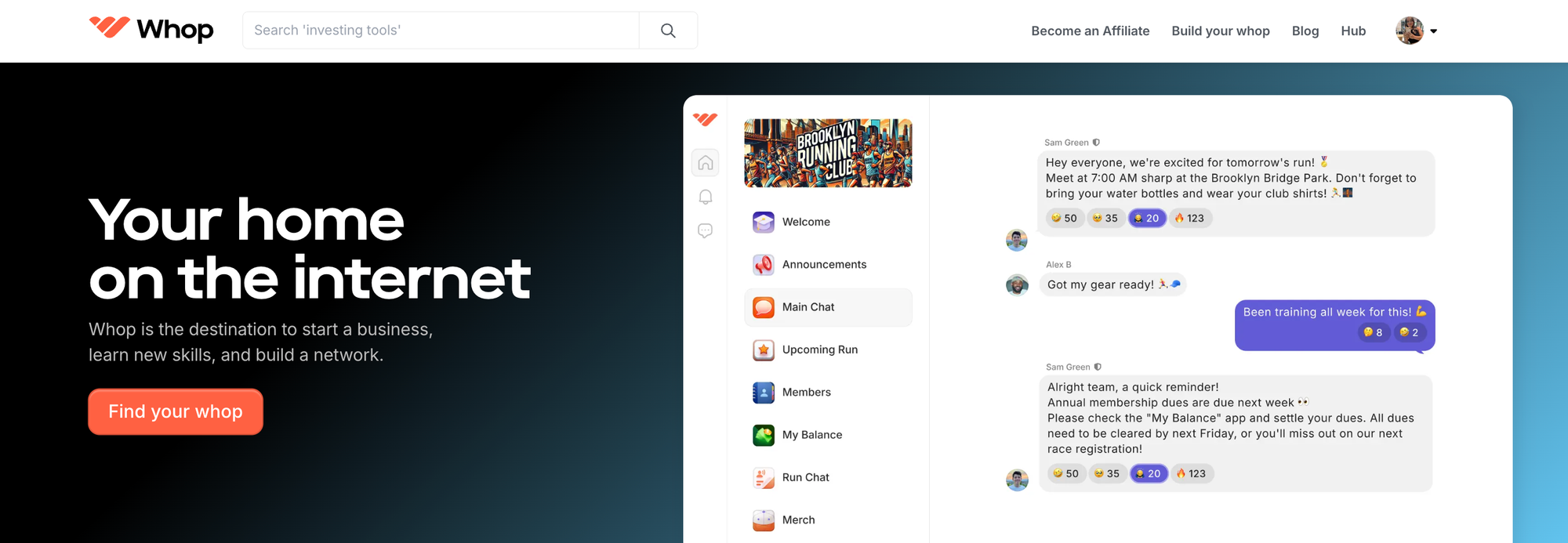
Once you’ve created a product you’re happy with, it’s time to start selling. Depending on your business model, you can upload the product to your online store, digital marketplace, ecommerce platform, or all three. Ensure your listings are compelling by including clear descriptions, engaging visuals, and relevant information about the product's benefits. Use your social media, mailing list, and any other funnels that you have to promote your product and direct your audience to buy.
Platforms like Whop provide an online marketplace and also serve as a place to build and nurture communities, answer FAQs, and do live demonstrations.
Creating and Selling Your Own Products With Resale Rights
And there you have it. Like we said, it’s simple. Plus, the earning potential doesn’t stop there. Once you’re comfortable with PLR, you can create your own products with resell rights.
For example, you might develop a comprehensive course on a specific topic, package it with resale rights, and offer it to other entrepreneurs who want to sell it.
Now, by creating and selling products with resale rights, you’re not just generating income from your own sales. You can benefit from a network of sellers promoting your products, too. Your reach and sales potential grow as other sellers distribute and market your products in their own channels.
The Pros and Cons of Selling PLR Products
As with any online hustle, selling PLR products comes with its own set of advantages and challenges.
| Pros | Cons |
|---|---|
| Time-saving | Competition can be higher |
| Less labor-intensive | Variability in PLR product quality |
| Cost-effective | Originality |
| Flexible | Reliance on external content |
| Opportunities for growth | Licensing understanding is crucial |
| Allows anyone to sell a course, ebook, etc. | Potential bias |
As you’ve probably noted by now, the main appeal of selling PLR products is saving time. Since the content is already created, you can bypass the development process. PLR products are also cost-effective, and the flexibility to modify and rebrand PLR products allows you to tailor them to your specific audience, which can help you stand out in the market.
Despite all those positives, there are still some drawbacks to consider. Since PLR products are available to multiple buyers, you may find yourself competing with others selling similar content. This is why adding your unique touch and additional value is crucial to standing out and succeeding. Another potential issue is the variability in quality. Not all PLR products are created equal, so selecting high-quality content from reputable sources is key. Lastly, because PLR products are not exclusive, they can lack the originality you get when creating content from scratch.
Weighing up these pros and cons can help you better decide whether PLR is right for you or if you’d rather build your own digital products from scratch.
Sell Your PLR Digital Products With Whop
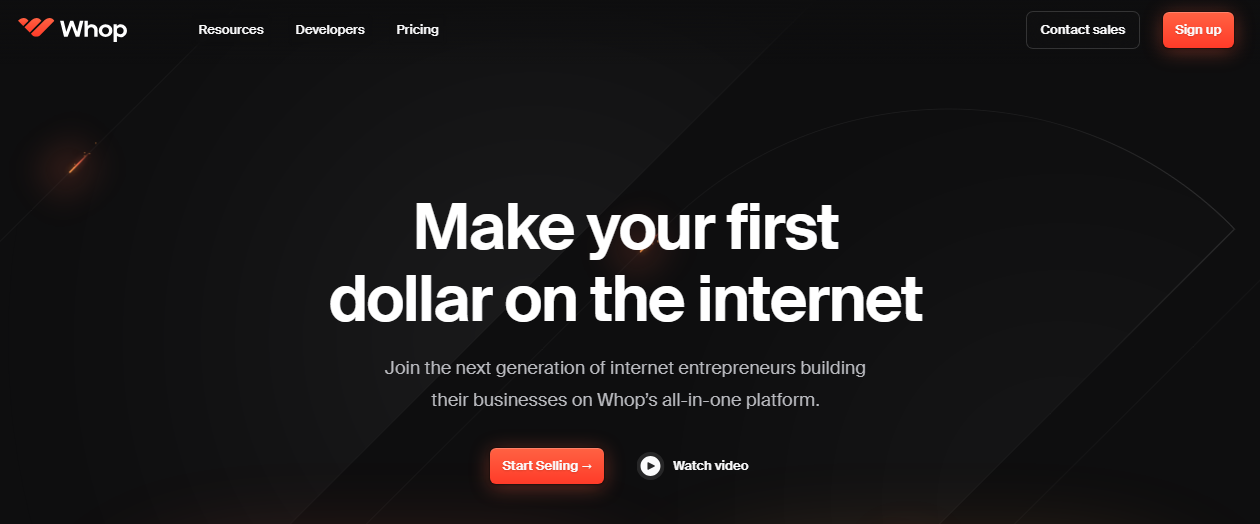
If you’re ready to sell PLR digital products, Whop offers the tools you need to get set up (and succeed).
With Whop you can sell almost any digital product. Whether you are selling ebooks, courses, or templates, you can do it with Whop. Plus, when you create your own whop hub, you can also create a community around your products. Let's say you rebrand a course to fit your business - you can create a community chat around this course to keep your buyers engaged. Then, you simply attach a price to your products and let people pay for access to your course, community, and whatever else you decide to sell with Whop.
Whop provides secure payment processing and gives you built-in marketing tools to help you reach your target audience. With Whop, you can focus on customizing your products and building your brand while we handle the technical aspects.
Plus, it’s free to get started. With no monthly or sign-up fee, you can start selling your digital products within the hour. Start selling with Whop today and make money online with your PLR digital products.
FAQs
What is the difference between PLR and other types of resale rights?
PLR (private label rights) allows you to modify and rebrand a product before selling it, giving you flexibility to make it unique to your brand. Resale rights only permit you to sell the product as-is, while master resale rights let you sell the product and grant resale rights to others. PLR offers you personalization and customization, whereas resale and master resale rights are more about redistribution without changes.
Can I use PLR content for my blog or website?
Yes, but it’s important to customize to ensure the content aligns with your brand and provides value to your audience. Always modify PLR content by adding your insights, updating information, and incorporating your brand’s voice. This helps avoid duplicate content issues and ensures the material resonates with your readers. Customized PLR content can enhance your online presence and improve engagement, while generic PLR content can do quite the opposite.
How can I ensure I purchase quality PLR products?
Try to purchase content from reputable providers known for their high standards. Head to the review sections of each listing to see what people are saying (and if the reviews seem genuine). Review sample content before purchasing to assess its quality and relevance–if any aren’t available, request it! Once you purchase your product, thoroughly review and edit the content to improve its quality and make it suitable for your audience. Quality control is essential for maintaining credibility when dealing with PLR products.
Are there any restrictions on selling PLR products?
While PLR products have broad usage rights, restrictions can vary depending on the license terms. Some PLR licenses may prohibit you from giving away the product for free, or they may limit how you can distribute it. To be on the safe side, always review the license agreement associated with each PLR product to understand any restrictions or conditions. If you don’t understand a term or condition, it pays to do some research.
How can I market PLR products effectively?
Effective marketing of PLR products involves creating a compelling product listing with clear descriptions and attractive visuals. Then, you want to use social media, email, and content marketing to reach your target audience. Highlight the unique features and benefits of your PLR products to differentiate them from competitors. Consider offering promotions, bundles, or limited-time offers to attract buyers. Engaging with your audience and providing value through marketing can boost visibility and drive sales.





